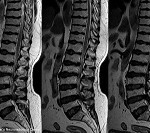 MRI (Magnetic Resonance Imaging) is a safe, painless, and potentially one of the most accurate, noninvasive procedures available to obtain images of the body. In many cases, a high quality MRI reveals exquisite anatomic detail and eliminates the need for additional diagnostic procedures.
MRI (Magnetic Resonance Imaging) is a safe, painless, and potentially one of the most accurate, noninvasive procedures available to obtain images of the body. In many cases, a high quality MRI reveals exquisite anatomic detail and eliminates the need for additional diagnostic procedures.
In MRI, a magnet is used in conjunction with radio waves and a sophisticated computer system to generate accurate images of the body without using any radiation. MRI is frequently used to study muscles, joints, the brain and spine, the abdomen, pelvis, chest and blood vessels.
Our vertical field open sided MRI machine is the largest in the state, and is perfect for multiple applications and enhances our Radiologists’ ability to interpret exams for conditions such as cardiac disease, vascular disease, stroke, musculoskeletal joint disorders, abdominal/pelvic conditions and brain disorders.
Mirror Imaging Las Vegas couples MRI technology with our Radiologists’ expertise to provide exams such as Breast MRI – a breakthrough study aiding in the diagnosis and staging of breast cancer.
The MRI Procedure
Because MRI uses a strong magnetic field, please notify your physician or our office prior to your exam if you have a pacemaker, artificial heart valve or any other metal inside your body. You should wear loose, comfortable clothing, and may be asked to wear a gown to prevent any magnetic interference with buckles or zippers.
You will be positioned on a cushioned table that will slide into the MRI machine. A Technologist will monitor the exam at all times and a speaker system keeps you connected to the Technologist.
Depending on the type of exam ordered a special coil may be used to image certain areas of the body, or a contrast agent may be injected through an IV. This is known as MRA, Magnetic Resonance Angiography, and is a procedure used to clearly see blood vessels.
A typical MRI exam takes approximately 30 – 45 minutes.
After an MRI Exam
Once the MRI study is complete, one of Mirror Imaging Las Vegas’ Radiologists will interpret the exam and report the findings to your physician. Your physician will contact you to discuss the results of your exam.







